Question
Spraying insecticide on the walls inside houses is the main method of controlling a species of Anopheles mosquito in rural India. A number of different insecticides have been used.
Malathion was the main insecticide used for many years. In 2005 the newer insecticide, deltamethrin, was used instead and the use of malathion was discontinued.
A laboratory study was carried out using mosquitoes collected from two sites in India. The percentage of mosquitoes killed by malathion and deltamethrin was estimated.
The results of the study are shown in Table 4.1
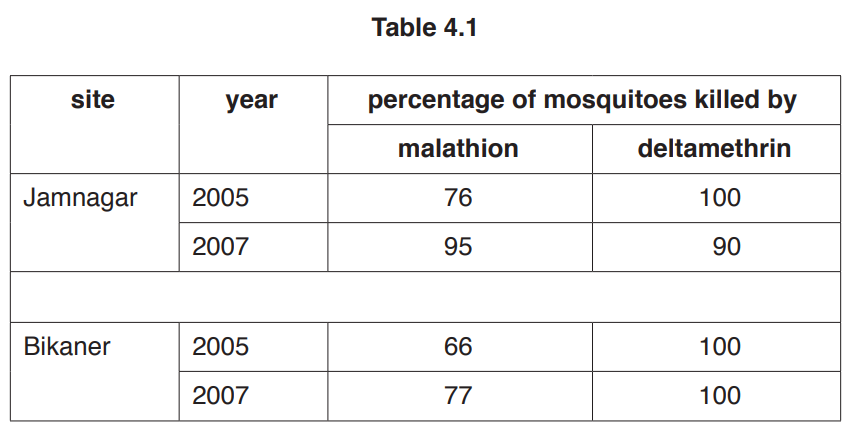
(a) With reference to Table 4.1, describe the difference in effectiveness of the two insecticides.[3]
(b) The researchers concluded that at Jamnagar, the mosquitoes had evolved resistance to deltamethrin.
Explain how the mosquitoes evolved resistance.[4]
(c) Explain how the data in Table 4.1 show evidence that the use of malathion was discontinued after 2005.[2]
(d) The resistance of mosquitoes to malathion was found to be due to a difference in the shape of one enzyme.
Name the type of variation controlling malathion resistance in the mosquito population.[1]
(e) Some students suggested that resistance to malathion could be due to a gene with two alleles. They proposed that the allele for resistance to malathion would be dominant to the allele for non-resistance.
Using this assumption, the data in Table 4.1 can be used to calculate the frequency of resistant mosquitoes and the frequency of the allele for resistance in a mosquito population.
Use the Hardy-Weinberg principle to calculate the frequency, p, of the allele for resistance in Jamnagar in 2005.[3] [Total: 13]
Answer/Explanation
Ans:
4(a) three from
1 (overall) deltamethrin, more effective / better, (at killing mosquitoes) ;
2 figures for malathion and deltamethrin with named site and year R Jamnagar in 2007 or mean 78.5% for malathion and 97.5% for deltamethrin ;
3 malathion, kills higher percentage (of mosquitoes)/is more effective, than deltamethrin in Jamnagar in 2007 ;
4 percentage of mosquitoes killed by deltamethrin decreasing in Jamnagar ;
5 percentage of mosquitoes killed by malathion increasing (in both locations) ;
4(b) four from
1 (random) mutation /genetic variation ; A description of mutation
2 deltamethrin acts as a selection pressure ;
3 resistant mosquitoes have selective advantage ; ora
4 resistant mosquitoes, survive /reproduce ; ora
5 resistance alleles passed on ;
6 increase in frequency of resistance allele ; ora
7 natural /directional, selection ;
4(c) two from
1 percentage of mosquitoes killed (by malathion) increases ;
2 (malathion) selection pressure removed /resistance to malathion is no longer a selective advantage ;
3 idea of resistance not needed ;
4(d) discontinuous ;
4(e) p=0.13 ; ; ;
allow max 2 for working
q2 / frequency of non-resistant (mosquitoes) = 0.76
q = 0.87
Question
The Hardy-Weinberg principle may be used to calculate allele and genotype frequencies for a gene, within a population.
The Hardy-Weinberg principle uses these equations:
p2 + 2pq + q2 = 1
p + q = 1
(a) Within a population of butterflies, the allele for brown wing colour, B, is dominant to the allele for white wing colour, b.
40% of the butterflies in this population are white.
Use the Hardy-Weinberg principle to calculate the percentage of butterflies in the population that are heterozygous for the gene controlling wing colour.
Show your working.
answer %[3]
(b) Describe four situations where the Hardy-Weinberg principle does not apply. [4] [Total: 7]
Answer/Explanation
Ans:
6(a) 46.5 – 47 ;;;
if answer incorrect allow marks for working
q2 = 0.4 ;
p = 0.368 OR p = 0.37 ;
6(b) four from:
1 mutation ;
2 migration (into, or out of, the population) ;
3 non-random mating occurs ;
4 the population is small ;
5 selective pressure occurs against one of the, alleles /genotypes ;
6 reproduction is asexual ;
7 organism is haploid ;
Question [Maximum marks: 12]
(a) The aye-aye, Daubentonia madagascariensis, is a primate native to Madagascar. Aye-ayes
are nocturnal (active at night) and make their nests high up in trees. They feed on insect
larvae in the trunks of trees.
Fig. 1.1 shows an aye-aye.
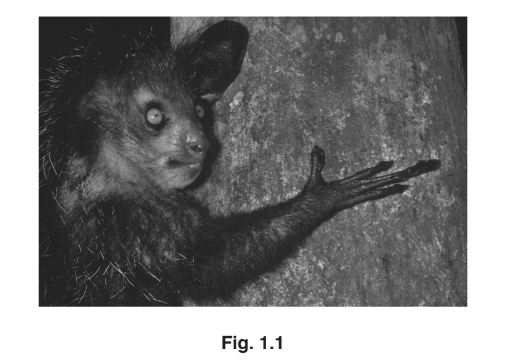
The International Union for Conservation of Nature (IUCN) is the world’s largest global
environmental organisation. The IUCN Red List of Threatened SpeciesTM evaluates the
conservation status of plant and animal species.
The aye-aye is categorised as endangered on the IUCN Red List, which means that it faces a
very high risk of becoming extinct in the wild.
(i) Name the domain to which the aye-aye belongs.
(ii) Suggest one reason why aye-ayes have become endangered.
(iii) Suggest ways in which zoos may help to protect this species from extinction.
(b) There are two main aye-aye populations on the island of Madagascar, one in the west and
one in the east.
Fig. 1.2 is a map of Madagascar showing the location of the two main populations.
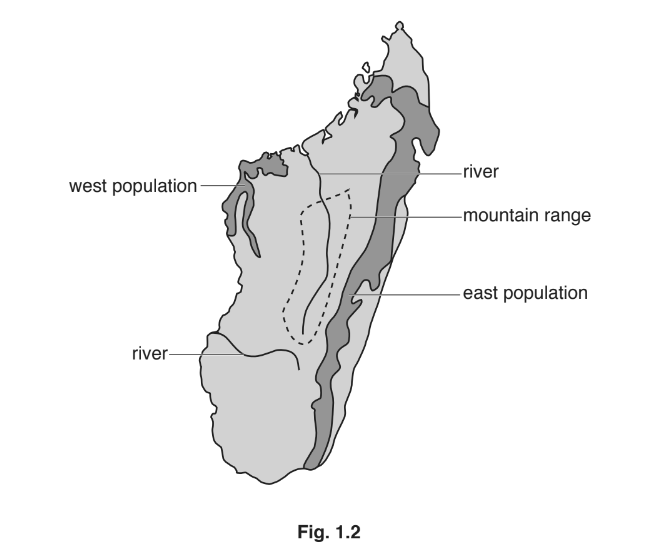
A study into the variation in the DNA nucleotide sequence of aye-ayes showed that there is
a large genetic difference between the west and east populations. The two populations of
aye-ayes may be evolving into separate species.
(i) With reference to Fig. 1.2, suggest why there is a large genetic difference between the two populations.
(ii) Name the type of speciation that may be occurring.
(iii) Suggest and explain a pre-zygotic isolating mechanism that could prevent successful reproduction between aye-ayes of the two populations.
Answer/Explanation
Answer: 1(a)(i) Eukarya ;
1(a)(ii) any one from: 1 habitat destruction / deforestation / logging ;
2 new disease ;
3 hunting ;
1(a)(iii) any three from: 1 captive breeding / AW ;
2 release into the wild ;
3 conservation projects (in Madagascar) / establish reserves ;
4 education / raise awareness ;
5 research ;
6 healthcare qualified ;
1(b)(i) any four from: 1 geographical, isolation / barrier ;
2 (due to) named barrier ; e.g. rivers / mountains
3 (west and east populations) unable to interbreed / no gene flow / AW ;
4 different, selection pressures / environmental conditions, (acting on west and east populations) ;
5 different mutations (in west and east populations) / AW ;
6 so different alleles selected for (in west and east populations) ;
7 ref. to genetic drift ;
8 (west and east populations) separated for a long time ;
1(b)(ii) allopatric ;
1(b)(iii) 1 physical / morphological / mechanical ; 2 reproductive features do not match / unable to mate ;
or
3 behaviour ;
4 different, calls / courtship rituals / AW ;
or
5 gametic / sperm and oocytes ;
6 fertilisation unsuccessful ;
or
7 temporal / AW ;
8 breed / fertile, at different times ;
Question
Scientists have found very little evolutionary change in populations of two Australian songbirds, the zebra finch, Taeniopygia guttata castanotis, and the budgerigar, Melopsittacus undulatus.
(a) Describe the process of evolution by natural selection.[4]
(b) The number of eggs a bird lays in its nest is called the clutch size.
The variation in clutch size was investigated in the zebra finch over several years.
The data are shown in Fig. 2.1.
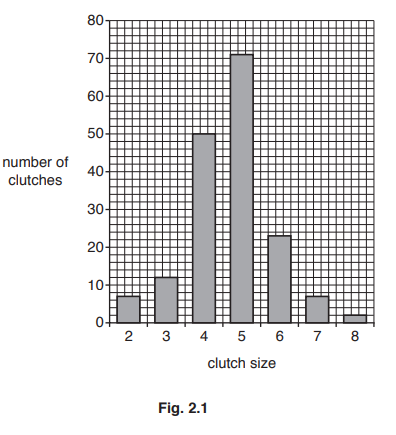
(i) Describe the pattern shown by the data in Fig. 2.1.[2]
(ii) The data in this investigation were collected over 60 years ago.
The same investigation, carried out today, would produce the same pattern of results.
Explain how the selection factors acting on zebra finches would maintain the same pattern of results.[4]
(c) The Hardy–Weinberg principle is used to calculate allele, genotype and phenotype frequencies in populations.
- A breeder of birds keeps a population of 86 budgerigars in one enclosed area.
- Two distinct phenotypes are present, blue feathers and green feathers.
- Feather colour is controlled by one gene:
- G is the allele for green feathers
- g is the allele for blue feathers.
- Only 17 of the budgerigars have blue feathers.
(i) The Hardy–Weinberg equations are shown in Fig. 2.2.
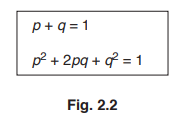
Calculate the number of heterozygous individuals in the population.
Show your working.[3]
number =
(ii) The Hardy–Weinberg principle cannot be applied to all populations.
State two conditions when the Hardy–Weinberg principle cannot be applied.[2]
1
2
[Total: 15]
Answer/Explanation
Ans:
2(a) any four from:
1 population / a species, show(s) genetic, variation / diversity ;
2 ref. to chance / random / spontaneous, mutation ;
3 ref. to selection pressure / competition / predation / disease ;
4 fitter / fittest OR better adapted / best adapted, (individuals) survive ; ora
5 reproduce / breed, more OR have more offspring ; ora
6 pass on, beneficial / advantageous / favourable / desirable, allele(s) ; ora
7 change / increase, in allele frequency ;
2(b)(i) any two from:
normal distribution ;
5 is, usual / commonest / most frequent / peak, clutch size ;
few(er) clutches, are very large and very small / are of size 2 and 8 / lie at (both) extremes ;
2(b)(ii) any four from:
1 stabilising selection ;
2 4 / 5 (eggs) or mean / average (clutch size),
is optimum / better / best / selected for / has selective advantage /
gives most (surviving) offspring ;
3 low clutch size / 2 / 3 , gives few(er) (surviving) offspring ;
4 high clutch size / 6 / 7 / 8 , not all offspring survive ;
5 high clutch size linked to more competition (between chicks) for, food / parental care ;
6 high clutch size linked to (more) predation (of eggs / chicks) ;
7 high clutch size linked to (more) disease (of eggs / chicks) ;
2(c)(i) step 1:
17 / 86 or 0.198 / 0.20 (q2) ;
step 2:
√ 0.198 or 0.445 / 0.45 / 0.44 (q) AND
1 – 0.445 or 0.555 / 0.55 / 0.56 (p) ;
step 3:
2 × 0.555 × 0.445 or 0.49(395) / 0.495 (2pq) AND
0.49(395) × 86 or 42 / 42.479 / 42.48 / 42.5 / 42.57 ;
2(c)(ii) any two from:
1 small population ;
2 (natural / artificial / sexual) selection ;
3 non-random mating / inbreeding ;
4 migration (of individuals) ;
5 (new) mutation (is occurring);
6 non-diploid organisms ;
7 overlapping generations ;
8 asexual reproduction ;
9 allele frequencies not equal in both sexes ;
